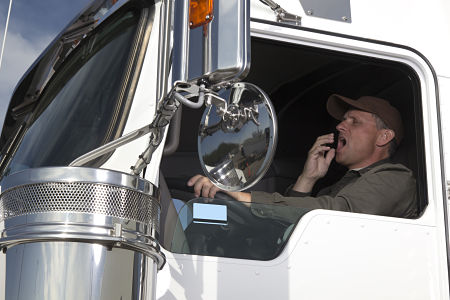ATRI releases results of sleep apnea study
The American Transportation Research Institute (ATRI) recently released the results of its sleep apnea survey, which highlights a number of issues related to truck driver screening and treatment of Obstructive Sleep Apnea (OSA).
With data from more than 800 commercial drivers, ATRI’s report is the first to quantify the costs and other impacts that truck drivers are experiencing as they address diagnosis and potential treatment regimen for OSA.
Among the findings:
- Among drivers who had been referred to a sleep study, 53 percent paid some or all of the test costs, with an average of $1,220 in out-of-pocket expenses, representing just over 1.5 weeks of median driver pay at $805 per week.
- Health insurance assistance with sleep study costs impacted driver out-of-pocket costs significantly – 61 percent of drivers with no health care coverage of their sleep study incurred out-of-pocket costs exceeding $1,000 compared to 32 percent of drivers whose health insurance did cover some portion of the sleep study with costs exceeding $1,000.
- Among drivers reporting time away from work associated with sleep apnea screening, 41 percent indicated days off ranging from 1 – 30 days.
- Use of a Continuous Positive Airway Pressure (CPAP) machine was the most commonly prescribed treatment regimen for drivers diagnosed with sleep apnea. This includes drivers in the ATRI sample diagnosed with mild sleep apnea, a condition that does not require treatment for medical certification.
- The number of drivers who report not adhering to a prescribed OSA treatment was only 1.95 percent of the moderate/severe OSA diagnosed respondents.
- Driver-perceived treatment efficacy varied by OSA severity. As OSA diagnosis severity increased, drivers experienced more positive CPAP treatment effects. For example, drivers diagnosed with severe OSA and being treated with CPAP reported increased amounts of sleep (84%), feeling better when they wake up (71%), and lower blood pressure (75%).
- Conversely, among the 91 percent of drivers being treated with CPAP — despite a diagnosis of mild sleep apnea — less than a third (32%) experienced improved sleep as a result of CPAP treatment.
- Among drivers who have had sleep studies and those who have not, there is concern about the use of neck circumference and Body Mass Index (BMI) as measures to refer drivers to sleep studies.
- Additionally, among drivers who have been tested, 64 percent believe that the DOT guidelines for referring drivers are too broad and that medical examiners do not follow the guidelines for referrals to sleep studies.
“ATRI’s research clearly shows what my fellow drivers and I have been experiencing. The costs associated with sleep apnea screening and treatment are not inconsequential for drivers and the flexibility to utilize lower cost options for both screening and treatment will be critical if FMCSA moves forward with a formal rulemaking,” said Barbara Beal, an owner-operator and member of OOIDA.
As a result of ATRI’s study, the Owner-Operator Independent Drivers Association (OOIDA) requested and received an extension to the Federal Motor Carrier Safety Administration’s comment period on its intent to develop a rule dealing with sleep apnea among truck drivers.
OOIDA asked for the extension to allow time to further review ATRI’s findings. FMCSA extended the comment period to July 8.
In a series of public listening sessions, FMCSA gathered the opinions of dozens of drivers, sleep specialists, and medical examiners on the subject.
“We want drivers to engage in the process and understand this isn’t just a regulatory activity to put new burdens and responsibilities on them,” said FMCSA Associate Administrator for Policy Larry Minor. “But we’re interested in their health and wellbeing, especially when they’re in a safety sensitive capacity.”
FMCSA and the Federal Railroad Administration (FRA) hosted listening sessions in Washington, D.C., Chicago and Los Angeles in May to solicit information on the prevalence of moderate-to-severe obstructive sleep apnea (OSA) among individuals occupying safety sensitive positions in highway and rail transportation, its potential consequences for the safety of rail and highway transportation, and the potential costs and benefits from regulatory actions that address the safety risks associated with motor carrier and rail transportation workers in safety sensitive positions who have OSA.
The listening sessions were intended to provide interested parties with an opportunity to share their views on this topic with representatives of both agencies, along with any data or analysis they may have.






